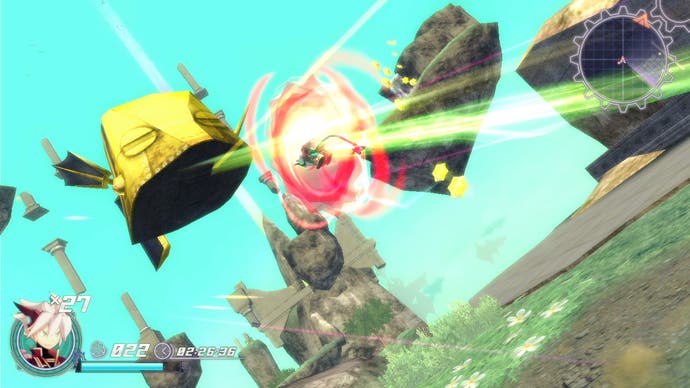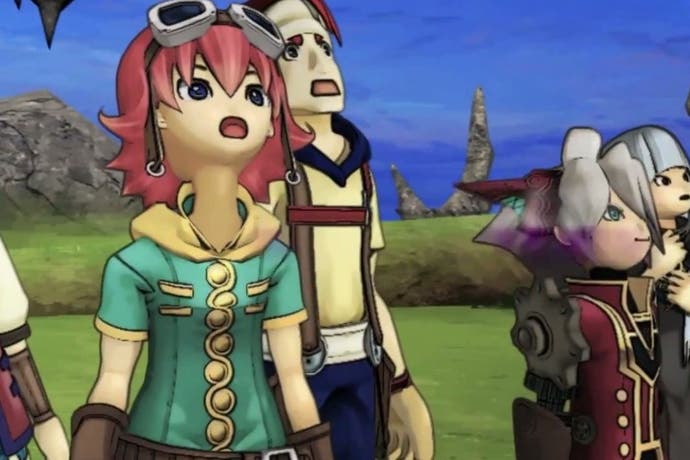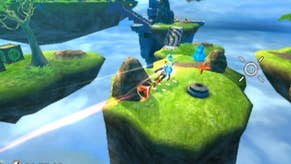Rodea The Sky Soldier review
Naka'd.
Ever play the game in which you must try to move from one side of a room to the other without touching the floor? The learning curve is low, but the risks are perilously high. Cracked lamps, bloody noses and scattered potpourri await the over-ambitious player, he who leaps from the arm of a sofa, over the baffled cat, only to put a clumsy foot through the coffee table. There's little grace involved, on those slow, wet childhood afternoons. Nevertheless, everyone involved believes, beforehand, that they'll move with enviable feline refinement, from mantelpiece, to lampshade to victory.
Rodea: The Sky Soldier's development team clearly had a similar hopeful vision for this project, in which you play as a quick-footed robot boy, able to hover and glide through the air. As you tumble off walls and enemies, so you recharge the titular boy's ability to fly with each rebound, prolonging the airtime. As in the child's game, Rodea rewards the player who is able to make it from one end of its massive, barren landscapes to the other without setting foot on ground. As in the child's game, the reality is often far less graceful than the dream.
Few game designers have floundered following the medium's broad transition from 2D to 3D in the mid-1990s as much as Yuji Naka, creator of Sonic the Hedgehog. Where the 2D, sideways-on perspective provided Naka with useful limitations, allowing his characters to tear from ramps and blast through walls, the principles largely failed with the transfer to 3D. Not one of the 3D Sonic games has come close to replicating the slick thrills of Naka's earliest games. Rodea: The Sky Soldier is a similar failure to translate a 2D Naka classic -- Nights Into Dreams, the Saturn platform-less flying game - to the third dimension.
Here, as in Nights, you tear through the air, searching for strings of floating coins, which will tug you along their trajectory in satisfying arcs, before splaying high up into the air, where you are free to angle up another dive. Rodea can glide unaided for around ten seconds, before he falters and falls to the ground. Bounce off an enemy, clang into a church bell (which saves your progress) or smash a crate and your store of energy replenishes. In this way the talented player is theoretically able to chain their way across the landscape, harvesting coins and items. The quicker you make it to the exit the better the grade you're awarded.

At times, the game comes close to the ideal of flowing, uninterrupted motion. It certainly rewards practice. Where many players will struggle during the first handful of its 20-odd stages, in time you learn the tricks and techniques needed to move with elegance. Originally planned as a Wii game (production was, reportedly, finished years ago, but the game's publisher delayed its release in order to debut on Wii-U instead) the shift away from that system's point-and-shoot control scheme adversely affects play. Where, presumably, you were able to point at a target on the screen and send Rodea tumbling off toward it, now you must line up a twitchy reticule while simultaneously wrestling with the camera.
As with so many of the recent Sonic games, the into-the-screen perspective hampers flow. It's easy to become disorientated and difficult to keep track of incoming attacks from enemies (Rodea has, notably, the most irritating homing missile warning sound yet heard in a video game, one made all the more frustrating as it's difficult to evade these projectiles flying blind). The game also encourages exploration; each stage contains numerous collectible trinkets. The slow act of searching for these on-foot, however, runs counter to the game's natural momentum. It jars.
An assortment of cogs and wheels can be collected from downed foes (a hapless invading force, send by the emperor of the neighbouring Naga continent whose daughter built Rodea as a way to foil her father's plans). These materials can then be used to permanently upgrade your character and his abilities, toughening armour, for example, or improving speed. The upgrade screen is somewhat tucked away in a side menu that can be accessed only from the world map, a relegation that will cause some players to simply breeze past the lumbering foes without realising that they're ripe with ability-improving fruit. Each stage also contains hidden bronze, silver and gold coins, which can be spent on unlocking bonus features and modes. Some of these provide Rodea with new attacks, others with miserly music tracks. One even unlocks a giddying first person mode. These unlocks are also tucked away and can be easily missed although, awareness of their presence won't necessarily convince anyone to go back and scour the woefully stark scenes for the necessary materials.
There are flashes of greatness within Rodea's rubble. In those rare moments when you're able to chain together winding combos of movement, soaring over the ground, Naka's outmoded genius can be felt. It's never enough. Nintendo's EAD proved with its duo of Super Mario Galaxy games that it's possible to fling a character through space in graceful arcs without the camera (or the player's misapplied agency) getting in the way. Without the safety bars of the 2D realm, Naka seems, time and again, unable to shepherd his players with similar sophistication. The disappointment is compounded by a paucity of ideas around Rodea's core substance. In one area you must collect herbs within a hollowed tree trunk, where there's barely space to swing a camera. For more than a decade now Naka has been searching for the kind of boundaries in which he was once able to flourish. The sky, it turns out, fails to offer a suitable limit.










